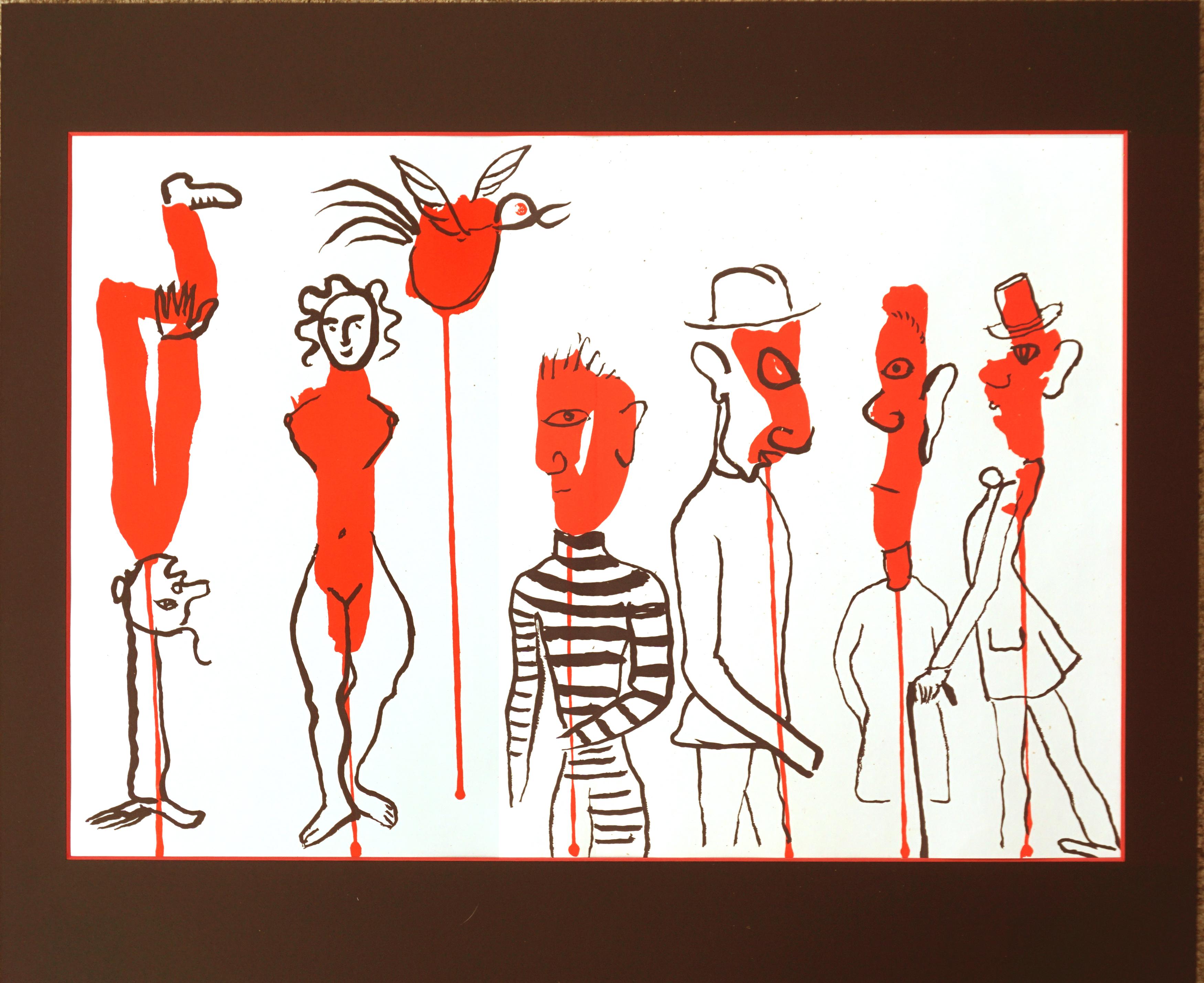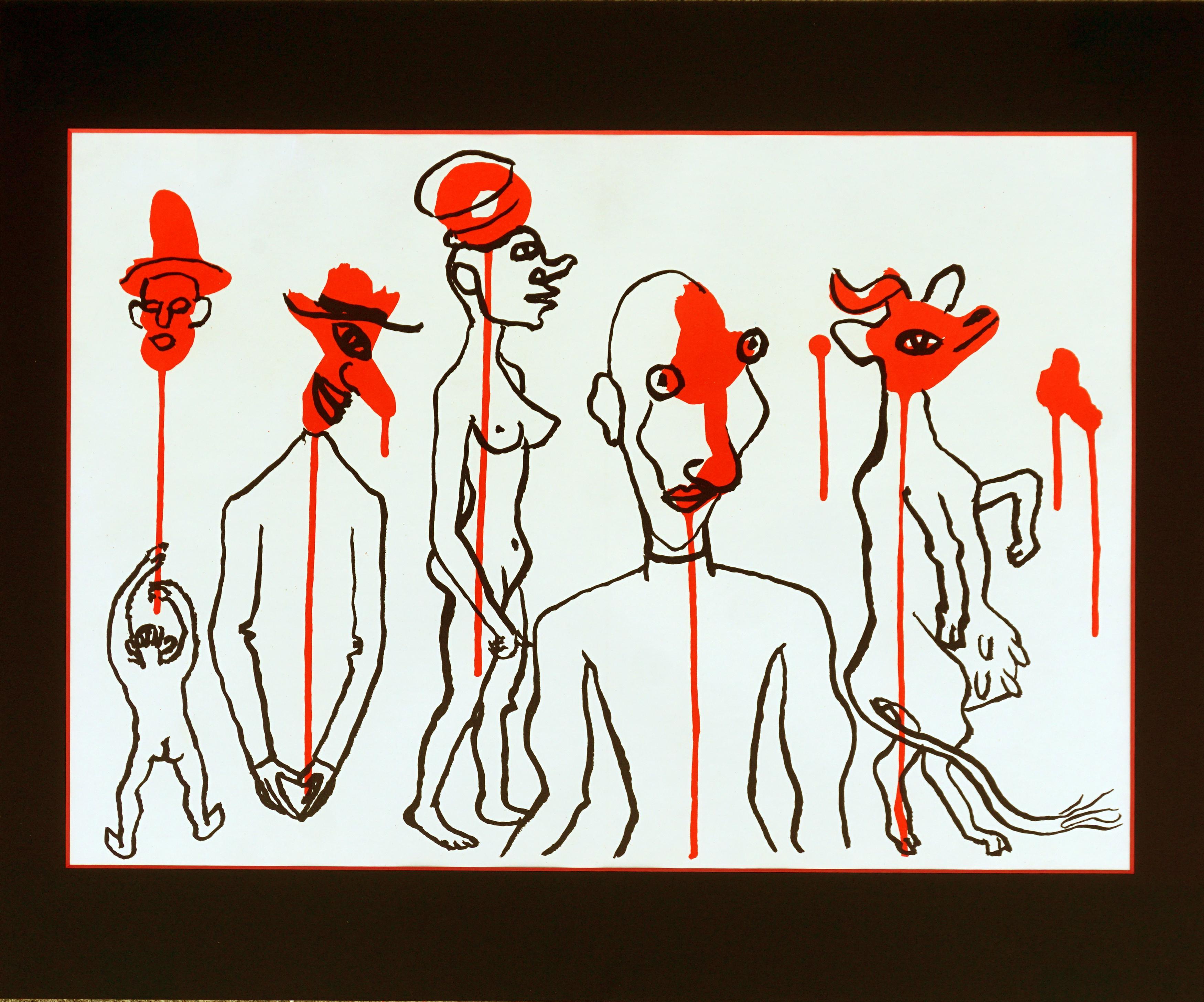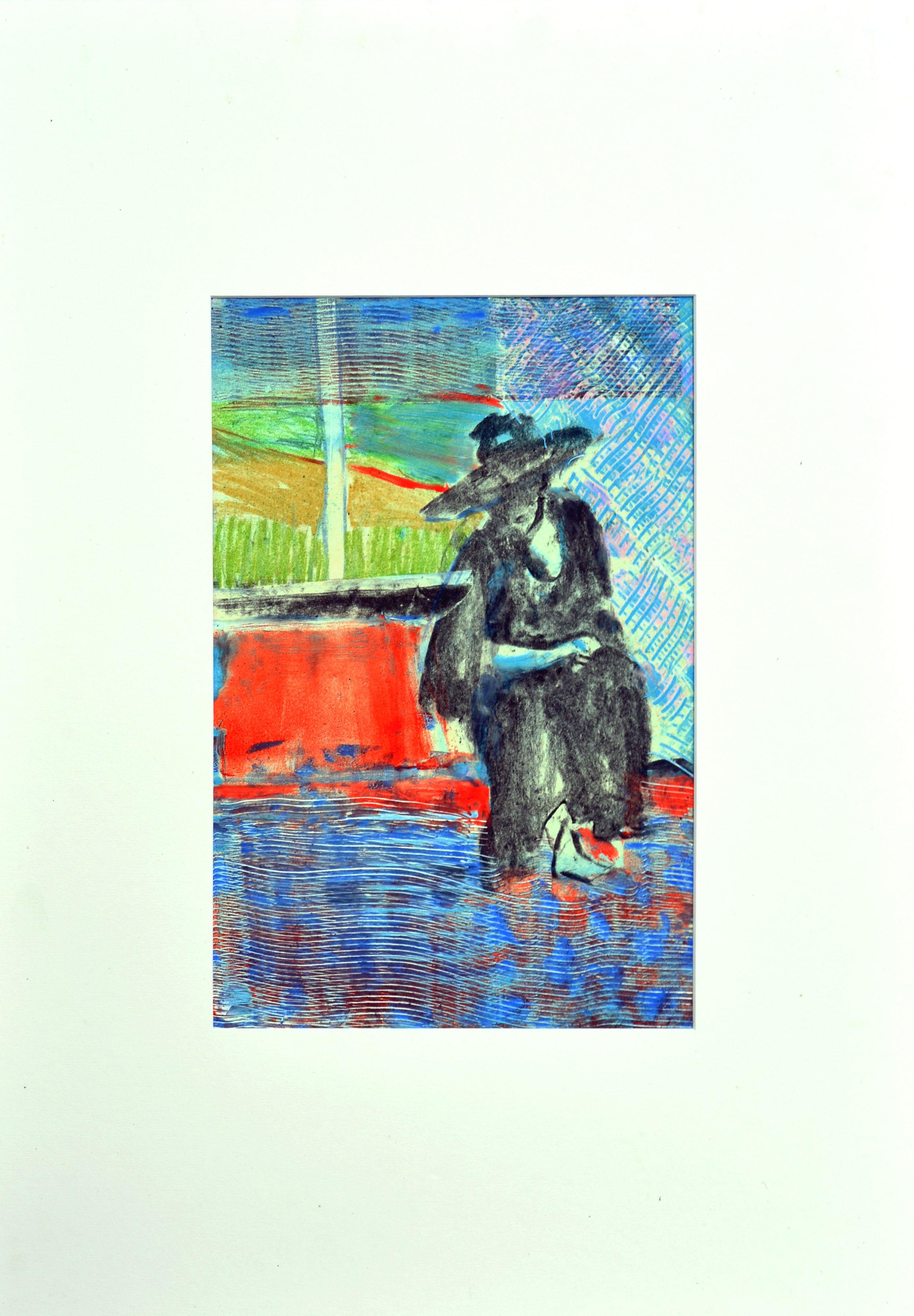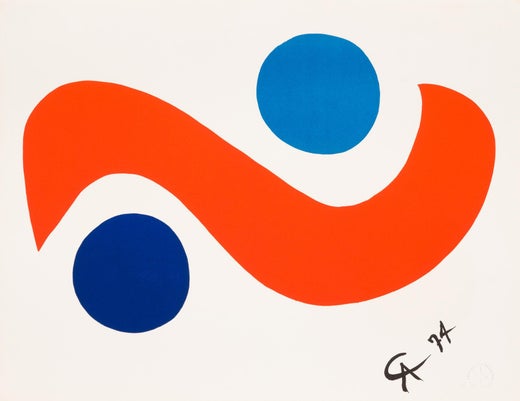Alexander CalderMid-Century Derrière le Miroir Lithograph by Alexander Calder 1966
1966
About the Item
- Creator:Alexander Calder (1898 - 1976, American)
- Creation Year:1966
- Dimensions:Height: 24 in (60.96 cm)Width: 30 in (76.2 cm)Depth: 0.33 in (8.39 mm)
- Medium:
- Movement & Style:
- Period:
- Condition:Very good condition. Fold-line as issued. Mat is new.
- Gallery Location:Soquel, CA
- Reference Number:
Alexander Calder
The American sculptor Alexander Calder is known as the father of the mobile, a moving artwork composed of delicately balanced sculptural forms suspended from the ceiling.
Because Calder's parents, both artists themselves, did not want him to suffer the hardships of trying to make a living in art, they encouraged the young Calder to study mechanical engineering at the Stevens Institute of Technology, in Hoboken, New Jersey. He worked a number of jobs, including as a hydraulic engineer and draftsman for the New York Edison Company, before deciding to pursue an artistic career. He never abandoned his engineering background, however, applying his understanding of gears and moving parts in all his artworks, from mechanical toys like the Cirque Calder (1931) and his revered prints to his free-standing abstract sculptures, called stabiles.
In 1926, Calder moved to Paris and established a studio in the Montparnasse quarter. He began creating the many parts of his famous miniature circus from found materials, such as wire, string, cloth, rubber and cork. Designed to be transportable, Cirque grew to fill five suitcases over the years. Always interested in putting forms in motion, Calder also pioneered a new art form called wire sculptures, which he described as “drawings in space.” Like his famous mobiles, the wire sculptures were suspended so that they turned with any movement of the air, presenting different forms when viewed from different angles.
In the 1950s, Calder returned to his roots in mechanical engineering, creating monumental abstract sculptures that verged on the architectural. He worked from loose gestural drawings like this preparatory sketch for his Man Stabile, from 1966. Throughout his career, he also worked as a set designer for the theater, as well as an illustrator and printmaker, producing vibrant, whimsical drawings for books and journals.
Find original Alexander Calder art today on 1stDibs.
- ShippingRetrieving quote...Ships From: Soquel, CA
- Return PolicyA return for this item may be initiated within 14 days of delivery.
- Alexander Calder Mid Century Derrière le Miroir LithographBy Alexander CalderLocated in Soquel, CAVintage 1960s Alexander Calder Lithograph double page part of portfolio "Derriere le Miroir". Published by: Galerie Maeght, Paris, 1966. No. 156. Text on verso. Unsigned from an unknown edition. Presented in black mat with red core. Mat size: 20"H x 24"W. Image size: 15"H x 22"W. American artist Alexander Calder changed the course of modern art by developing an innovative method of sculpting, bending, and twisting wire to create three-dimensional “drawings in space.” Resonating with the Futurists and Constructivists, as well as the language of early nonobjective painting, Calder’s mobiles (a term coined by Marcel Duchamp in 1931 to describe his work) consist of abstract shapes made of industrial materials––often poetic and gracefully formed and at times boldly colored––that hang in an uncanny, perfect balance. His complex assemblage Cirque Calder (1926–31), which allowed for the artist’s manipulation of its various characters presented before an audience, predated Performance Art by some 40 years. Later in his career, Calder devoted himself to making outdoor monumental sculptures...Category
1960s Modern Figurative Prints
MaterialsPaper, Ink
- Alexander Calder Mid Century Derrière le Miroir LithographBy Alexander CalderLocated in Soquel, CAVintage 1960s Alexander Calder Lithograph double page part of portfolio "Derriere le Miroir". Published by: Galerie Maeght, Paris, 1966. No. 156. Text on verso. Unsigned, from an unknown edition. Presented in black mat with red core. Mat size: 20"H x 24"W. Image size: 15"H x 22"W. American artist Alexander Calder changed the course of modern art by developing an innovative method of sculpting, bending, and twisting wire to create three-dimensional “drawings in space.” Resonating with the Futurists and Constructivists, as well as the language of early nonobjective painting, Calder’s mobiles (a term coined by Marcel Duchamp in 1931 to describe his work) consist of abstract shapes made of industrial materials––often poetic and gracefully formed and at times boldly colored––that hang in an uncanny, perfect balance. His complex assemblage Cirque Calder (1926–31), which allowed for the artist’s manipulation of its various characters presented before an audience, predated Performance Art by some 40 years. Later in his career, Calder devoted himself to making outdoor monumental sculptures...Category
1960s Modern Figurative Prints
MaterialsPaper, Ink
- Two Faces, Modern Self-Portrait Lithograph of the Artist Aging in Pink & GreenBy Dennis John AshbaughLocated in Soquel, CALimited edition hand signed lithograph featuring two consecutive modern portraits of faces with varying degrees of abstraction, in pink and green, by Dennis john Ashbaugh (American, b. 1946). Numbered "7/7" in the lower-left corner. Signed "Dennis John Ashbaugh" in the lower right corner. Presented in a new tan mat with foam core backing. Unframe. Image size: 4"H x 6.75"W. Some toning yellowing at mat opening. Dennis John Ashbaugh (American, b. 1946) was born in Red Oak, Iowa, and attended California State University at Fullerton, receiving his MA in 1969. Ashbaugh has spent most of his career in New York City. In 1992, he collaborated with William Gibson, a fiction writer, and with publisher Kevin Begos on a book, Agrippa, meaning 'book of the dead'. Exhibition venues include the Metropolitan Museum of Art in New York City, the P.S.1 Contemporary Art Center, the Seattle Art Museum, and the Whitney Museum of American ArtPublic collections holding his work include the Hirshhorn Museum, the Museum of Fine Arts, Houston, the Los Angeles County Museum of Art, and the New York Metropolitan. He received a Guggenheim Fellowship. Ashbaugh lives in a trim frame house in Flamingo Park...Category
1970s Modern Figurative Prints
MaterialsPaper, Ink, Lithograph
- Figurative Abstract -- Man at the WellLocated in Soquel, CAFigurative abstract with a colorful textured background and figure in black by an unknown artist (American, 20th Century). Hand pulled lithograph with hand work augmentation. Unsign...Category
1980s Modern Figurative Prints
MaterialsPaper, Ink
- Portrait of Modern Man - Multilayer Woodblock in Ink on PaperLocated in Soquel, CAPortrait of Anger - Multilayer Woodblock in Ink on Paper Bold and saturated woodblock print of a screaming man by Michael Dow (American, 20th Century). The man is centered in this m...Category
1990s American Modern Figurative Prints
MaterialsPaper, Ink, Woodcut
- The Faceless, Unforgettable Three - Modernist Color Lithograph (5/100)By Simon AvissarLocated in Soquel, CAThe Faceless, Unforgettable Three - Modernist Color Lithograph (5/100) Three faceless figures, created by Simon Avissar (Israeli, 1938-2020), in a cool, muted color palette of purple and teal, layered against a speckled background with a sense of light surrounding them. Presented in a new taupe-colored mat. Mat size: 30"H x 24"W Paper size: 25.5"H x 19"W Avissar, Simon (Israeli, 1938-2020) is a Postwar & Contemporary painter born in Casablanca. As a tireless nomad, he exhibited for the first time in 1961, in Jaffa, where he lived and worked for some time. He then moved to Paris, settling into a studio in Montparnasse and began with an exhibition of his work at the Galerie Charpentier in 1964, and after exhibited at Abel Rambert, the Galerie de l’Elysée, and the Galerie Bénézit in the 14 years he lived there. He then moved to the United States, including Washington, New York, and Lose Angeles, while continuing to travel to South America, Australia, and South Africa, exhibiting in many places he visited. His work integrates the contributions of the avant-garde with cubist simplification, chromatic audacity, and abstract geometry. Education 1959-1960 School of Arts Appliques, Paris, France 1959-1961 L'Ecole des Beaux Arts, Paris, France 1962-1963 Bezalel Academy of Art & Design, Jerusalem Awards 1964 The French Ambassador’s Special Award Environmental Sculptures...Category
20th Century Modern Figurative Prints
MaterialsPaper, Printer's Ink
- Future III: modernist urban architectural monoprint & collage in gray blue blackLocated in Bryn Mawr, PA"Future III" is a Bauhaus-inspired monotype and collage (work on paper) reminiscent of the aesthetic of Le Corbusier. It is part of Bouton’s "Habitat and Urban Matter" series, which is inspired by the straight lines of modernist architecture and hard-edged geometrical forms of the urban environment. Bouton, a French printmaker from Paris who has also lived in London, Myanmar, Ivory Coast, Senegal, and Turkey, creates work that responds to her experiences during her travels and the cultures she encountered. Since settling in the Philadelphia area, she has been inspired by the urbanism of the city, whether a sleek, new apartment block, an abandoned warehouse, or a half-demolished home. Her latest works are interpretations of these buildings, with both broad street views and focused details from single structures –- the pattern of the skyline, a patchwork of broken windows, an industrial color palette. She is drawn to the history of the spaces and lives lived within these buildings, as well as their intrinsic beauty of the structures, whether that beauty emerges from design or degradation, or some combination of the two. Signed and dated. Bouton is a French artist living and working in the Philadelphia area whose boundary-pushing printmaking and paper works exhibit influence from living and working in international cities across the globe. Bouton earned her BFA in Painting and Printmaking and her MFA in Arts and Textile Design from the prestigious ESSAA Duperré in Paris, France. Since leaving Paris 15 years ago, Bouton has lived and exhibited her work internationally in Paris (France), London (UK), Philadelphia (USA), Rangoon (Burma/Myanmar), Abidjan (Ivory Coast), Dakar (Senegal) and Istanbul (Turkey). She has presented solo exhibitions at the Biennale de l’Art Africain...Category
2010s Modern Figurative Prints
MaterialsInk, Archival Paper, Monoprint, Monotype
- 'Figural Abstraction' original black and white block print by Sylvia SpicuzzaBy Sylvia SpicuzzaLocated in Milwaukee, WI'Figural Abstraction' is an original block print by American artist and teacher Sylvia Spicuzza. The image, printed in white ink against a grey paper, presents bold and graphic figur...Category
Mid-20th Century Modern Abstract Prints
MaterialsPaper, Ink
- Victor Guadalajara, "Intersections", 2009, Woodcut 16x12inBy Victor GuadalajaraLocated in Miami, FLVictor Guadalajara (Mexican, 1965) 'Intersecciones', 2009 Woodcut and Aquatint 100.00 x 185 cm. (39.4 x 72.8 in.) Edition of 30 UnframedCategory
Early 2000s Modern Abstract Prints
MaterialsPaper, Ink, Engraving, Etching, Woodcut
- Abstract Landscape India Edition 3/5 Linocut Print Nature Red Orange BlackBy Mukesh SharmaLocated in Norfolk, GBThere is a natural and raw understanding in Mukesh Sharma’s prints that both depict, and are influenced by, the Rajastani communities of his home town in rural India. In these Limited Edition fine-art prints, made over a period of twenty years, we are offered the colours of India’s ancient land, the textures, light and the patterns that are everywhere. In the patterns of the arable fields to the jali's (carved screens) in the architecture. This work is however not romantic nor nostalgic but shows a deeper rooted need to offer a visual heritage of place, of where the artist is from and the journey that he is taking. The results are both compelling and honest. Mukesh Sharma, Celebration “O”, Lino-cut chin-coll’e on German Ivory paper Edition: 3 of 5, 2005 Image size: 50 x 33 cm / Sheet size: 79 x 55 cm Unframed "In this piece I use multiple layering of image, repetition of shape, layered shapes to inform my life celebration and my investigation into Indian culture" Mukesh Sharma's work: It is often in childhood that paths are set for what we will become. Mukesh Sharma hails from a rural, agricultural village in Rajasthan, India. His Father is a craftsman who fixed and mended farm machinery and understood the working parts in the processes. Sharma followed in his Father’s footsteps, as is often the case in Indian families, but his was not the machines of the fields but the presses of the printing studio. Like his Father, Mukesh Sharma is fascinated with understanding how things work and how he can manipulate the metal in his hands. It is not surprising then that his medium of choice is printing. One of the most physically challenging of all the practices, it can often be physically challenging as well as technical and detailed. In his youth, Sharma would draw with stones on walls and floors. He was lucky his family encouraged this and he is grateful for his early art-training at the Jaipur School of Art but it was at the Baroda Art Department that he was introduced to the great printing traditions of Jyoti Bhatt...Category
Early 2000s Abstract Abstract Prints
MaterialsArchival Ink, Archival Paper, Linocut, Archival Pigment
- Abstract India Edition 3/5 Linocut Print Nature Love Purple Blue TurquoiseBy Mukesh SharmaLocated in Norfolk, GBThere is a natural and raw understanding in Mukesh Sharma’s prints that both depict, and are influenced by, the Rajastani communities of his home town in rural India. In these Limite...Category
Early 2000s Abstract Abstract Prints
MaterialsArchival Ink, Archival Paper, Linocut, Archival Pigment
- Abstract Landscape India Edition 3/5 Linocut Print Nature Red Navy PrimitiveBy Mukesh SharmaLocated in Norfolk, GBThere is a natural and raw understanding in Mukesh Sharma’s prints that both depict, and are influenced by, the Rajastani communities of his home town in rural India. In these Limited Edition fine-art prints, made over a period of twenty years, we are offered the colours of India’s ancient land, the textures, light and the patterns that are everywhere. In the patterns of the arable fields to the jali's (carved screens) in the architecture. This work is however not romantic nor nostalgic but shows a deeper rooted need to offer a visual heritage of place, of where the artist is from and the journey that he is taking. The results are both compelling and honest. Mukesh Sharma, Frenzy M3, Lino-cut chin-coll’e on German Ivory paper Edition: 3 of 5, 2005 Image size: 50 x 33 cm / Sheet size: 79 x 55 cm Unframed 'In this work in particular I feel that a true work of art is the creation of an experience from the interaction between the human self and the outside world' Mukesh Sharma's work: It is often in childhood that paths are set for what we will become. Mukesh Sharma hails from a rural, agricultural village in Rajasthan, India. His Father is a craftsman who fixed and mended farm machinery and understood the working parts in the processes. Sharma followed in his Father’s footsteps, as is often the case in Indian families, but his was not the machines of the fields but the presses of the printing studio. Like his Father, Mukesh Sharma is fascinated with understanding how things work and how he can manipulate the metal in his hands. It is not surprising then that his medium of choice is printing. One of the most physically challenging of all the practices, it can often be physically challenging as well as technical and detailed. In his youth, Sharma would draw with stones on walls and floors. He was lucky his family encouraged this and he is grateful for his early art-training at the Jaipur School of Art but it was at the Baroda Art Department that he was introduced to the great printing traditions of Jyoti Bhatt...Category
Early 2000s Abstract Abstract Prints
MaterialsArchival Ink, Archival Paper, Linocut, Archival Pigment
Recently Viewed
View AllRead More
Renowned for His Mobiles, Alexander Calder Was Also Adept at Crafting Modernist Jewelry
There are no sparkling gemstones on this necklace, but its value far exceeds the cost of its materials.
10 Must-Visit American Public Sculptures
Get your dose of Vitamin D while surveying works by the likes of Alexander Calder, Keith Haring and Pablo Picasso.






